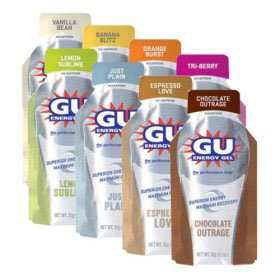

Performance Enhancing Supplements:
Part 5, To GU or not to GU
By certified sports nutritionist Marcia Homer, MS, CSN
Back to list of our training, coaching and nutrition essays

Les Woodland's book Cycling's 50 Triumphs and Tragedies: The Rise and Fall of Bicycle Racing's Champions is available as an audiobook here. For the print and Kindle eBook versions, just click on the Amazon link on the right.
Marcia Homer writes:
One of the most common questions I get as an endurance athlete is this: “Do you use Gu?” I just completed my 10th Hood to Coast (the most awesome relay on earth - yes – your team actually covers the 198 miles from Mt. Hood to the Oregon coast) and I was probably asked that question five different times. My answer is always the same: “I am a huge Gu convert”. “Convert” meaning I wasn’t always sold on the somewhat tricky act of swallowing some slimy substance after the nearly impossible feat of opening its container - a slick portable packet apparently made from some of the strongest substances on earth. But, pain and exhaustion are excellent motivators – as I was soon to discover. And what’s a little messy compared to a marathon finisher’s medal?

Should you use GU? Marcia Homer looks at the science to answer the question
My Gu conversion took place during the mid-1990s. I was running my 7th St. George Marathon – my favorite marathon on the planet. We had yet to be inundated with every piece of nutritional advice ever created (via the internet) so I had my trusty Runner’s World to manage every piece of my training plan and fueling during exercise was somewhat new to me. I was coming up on mile 18 and, let’s just say it, I was done. Done. I had more than 8 miles to go and the tank was empty. My legs felt like cement, my hips were screaming and I had started questioning every single decision I had made in my entire life – beginning with the decision to run that marathon. As I came hobbling up to the mile 18 aid station, I heard shouts of “Gu” coming from the tables at the back of the station. I literally thought “What do I have to lose?” I grabbed 2 packets, oblivious to the flavor, and, swearing profusely, my sweaty, slippery hands finally got them open and into my system. Within 15 minutes, I was almost like a new runner. My legs found a little pep, I sped up, the pain eased and I was able to finish without making the usual sweeping declaration of “I will never do this again” which normally accompanied every marathon finisher’s medallion.
There is plenty of science to back up my mile 18 experience. As an endurance athlete and a marathon runner, most of my life has been about the pursuit of carbohydrates. Simple carbohydrates – such as is found in Gu and other popular energy gels – are a critical and important fuel during exercise. In the 1960s, it became clear that muscle glycogen played a significant role during exercise, and in the 1980s, the first studies showed that carbohydrate ingestion during exercise improved exercise capacity.
The guidelines for carbohydrate ingestion vary widely based on a number of historical studies but the most recent guidelines by the American College of Sports Medicine (ACSM) state that carbohydrate intake of 30-60 g/h (grams per hour) is recommended during prolonged exercise (Jeukendrup, 2014). One packet of energy gel (Gu) contains 32 grams. I’ve found one gel every 45-55 minutes works well for me.
As with any fuel, the consumption of that fuel is in proportion to the intensity of the movement. With increasing exercise intensity, the active muscle mass becomes more and more dependent on carbohydrate as a source of energy. The Journal of Sports Science and Medicine reported on a 2012 study that analyzed every race at the 2012 World Cup men’s slalom ski season. These courses included a combination of both complex movement and high speed. The participants ingested 30-35 grams of a carbohydrate gel every hour. The success rates of the skiers who ingested the gel improved dramatically over the course of the study. Their ski run time differences, the number of gates completed and the rating of perceived exertion (RPE) all improved based on the consumption of an energy gel (Seifert et al., 2012).
Also, a large study of endurance events by Pfeiffer et al. 2012 demonstrated a wide variation in carbohydrate intake reported by athletes between and within events, with the highest intakes in cycling and triathlon events. In that study, Pfeiffer also found that in Ironman races, carbohydrate intake was related to finish time, with greater carbohydrate intake correlating to better performance and lower finishing times.
So, for me the answer is pretty clear. Carbs during exercise are a necessity for me – and my choice is Gu. Remember: carbohydrate intake can be achieved by consuming drinks (Gatorade), gels (Gu), or bars (Powerbars, Cliff Bars, etc.) and, obviously, personal preference will drive your choice. However, keep in mind, hydration is a MUST when carbo-loading mid-run or mid-ride. Be sure your carbohydrate intake plan is accompanied by a solid hydration plan. Solid foods and highly concentrated carbohydrate solutions have been shown to reduce fluid absorption. So, have that Gu ready – but be sure you have at least 8-12 ounces of water with which to wash it down and ensure that glycogen gets into your muscles ASAP.
Then – for everyone’s sake – grab an extra cup and wash the sticky off your hands. Your huggable fan base at the finish line will thank you.
Marcia holds a Master of Applied Exercise Science degree from Concordia University, Chicago. She is also an ACE certified Health Coach as well as a Certified Sports Nutritionist through the International Society of Sports Nutrition. As a marathon runnerX45, Hood-to-Coast captain, Ironman triathlete, Tough Mudder and Crossfit Masters competitor, Marcia knows first-hand the importance of proper nutrition in endurance sports.
References
Jeukendrup, A. (2014). A Step Towards Personalized Sports Nutrition: Carbohydrate Intake During Exercise [Abstract]. Sports Medicine, 44, 25-33.
Pfeiffer, B., Stellingwerff, T., & Hodgson, A. (2012). Nutritional intake and gastrointestinal problems during competitive endurance events [Abstract]. Medicine & Science in Sports & Exercise, 44, 344-351.
Seifert, J. G., Kipp, R. W., & Bacharach, D. W. (2012). The effects of a carbohydrate-protein gel supplement on alpine ski performance [Abstract]. Journal of Sports Science and Medicine, 11, 537-541.







